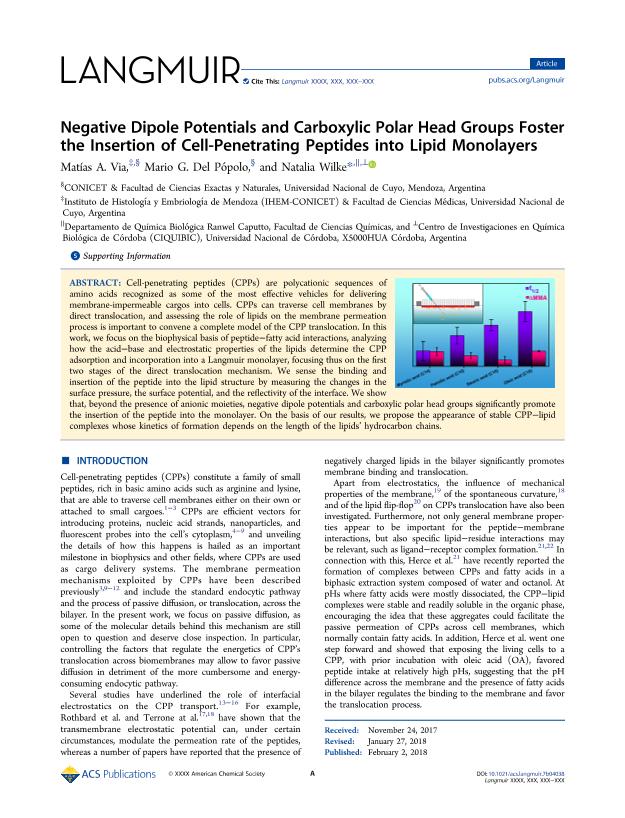Mostrar el registro sencillo del ítem
dc.contributor.author
Via, Matías Alejandro

dc.contributor.author
del Popolo, Mario Gabriel

dc.contributor.author
Wilke, Natalia

dc.date.available
2020-01-24T22:59:29Z
dc.date.issued
2018-03
dc.identifier.citation
Via, Matías Alejandro; del Popolo, Mario Gabriel; Wilke, Natalia; Negative Dipole Potentials and Carboxylic Polar Head Groups Foster the Insertion of Cell-Penetrating Peptides into Lipid Monolayers; American Chemical Society; Langmuir; 34; 9; 3-2018; 3102-3111
dc.identifier.issn
0743-7463
dc.identifier.uri
http://hdl.handle.net/11336/95820
dc.description.abstract
Cell-penetrating peptides (CPPs) are polycationic sequences of amino acids recognized as some of the most effective vehicles for delivering membrane-impermeable cargos into cells. CPPs can traverse cell membranes by direct translocation, and assessing the role of lipids on the membrane permeation process is important to convene a complete model of the CPP translocation. In this work, we focus on the biophysical basis of peptide-fatty acid interactions, analyzing how the acid-base and electrostatic properties of the lipids determine the CPP adsorption and incorporation into a Langmuir monolayer, focusing thus on the first two stages of the direct translocation mechanism. We sense the binding and insertion of the peptide into the lipid structure by measuring the changes in the surface pressure, the surface potential, and the reflectivity of the interface. We show that, beyond the presence of anionic moieties, negative dipole potentials and carboxylic polar head groups significantly promote the insertion of the peptide into the monolayer. On the basis of our results, we propose the appearance of stable CPP-lipid complexes whose kinetics of formation depends on the length of the lipids' hydrocarbon chains.
dc.format
application/pdf
dc.language.iso
eng
dc.publisher
American Chemical Society

dc.rights
info:eu-repo/semantics/openAccess
dc.rights.uri
https://creativecommons.org/licenses/by-nc-sa/2.5/ar/
dc.subject
POLYARGININES
dc.subject
LIPID BILAYER
dc.subject
FATTY ACIDS
dc.subject
NEGATIVE DIPOLE
dc.subject.classification
Físico-Química, Ciencia de los Polímeros, Electroquímica

dc.subject.classification
Ciencias Químicas

dc.subject.classification
CIENCIAS NATURALES Y EXACTAS

dc.title
Negative Dipole Potentials and Carboxylic Polar Head Groups Foster the Insertion of Cell-Penetrating Peptides into Lipid Monolayers
dc.type
info:eu-repo/semantics/article
dc.type
info:ar-repo/semantics/artículo
dc.type
info:eu-repo/semantics/publishedVersion
dc.date.updated
2019-10-21T20:07:15Z
dc.journal.volume
34
dc.journal.number
9
dc.journal.pagination
3102-3111
dc.journal.pais
Estados Unidos

dc.journal.ciudad
Washington DC
dc.description.fil
Fil: Via, Matías Alejandro. Consejo Nacional de Investigaciones Científicas y Técnicas. Centro Científico Tecnológico Conicet - Mendoza. Instituto de Histología y Embriología de Mendoza Dr. Mario H. Burgos. Universidad Nacional de Cuyo. Facultad de Ciencias Médicas. Instituto de Histología y Embriología de Mendoza Dr. Mario H. Burgos; Argentina
dc.description.fil
Fil: del Popolo, Mario Gabriel. Consejo Nacional de Investigaciones Científicas y Técnicas. Centro Científico Tecnológico Conicet - Mendoza; Argentina. Universidad Nacional de Cuyo. Facultad de Ciencias Exactas y Naturales; Argentina
dc.description.fil
Fil: Wilke, Natalia. Consejo Nacional de Investigaciones Científicas y Técnicas. Centro Científico Tecnológico Conicet - Córdoba. Centro de Investigaciones en Química Biológica de Córdoba. Universidad Nacional de Córdoba. Facultad de Ciencias Químicas. Centro de Investigaciones en Química Biológica de Córdoba; Argentina. Universidad Nacional de Córdoba. Facultad de Ciencias Químicas. Departamento de Química Biológica; Argentina
dc.journal.title
Langmuir

dc.relation.alternativeid
info:eu-repo/semantics/altIdentifier/url/http://pubs.acs.org/doi/10.1021/acs.langmuir.7b04038
dc.relation.alternativeid
info:eu-repo/semantics/altIdentifier/doi/https://doi.org/10.1021/acs.langmuir.7b04038
Archivos asociados
